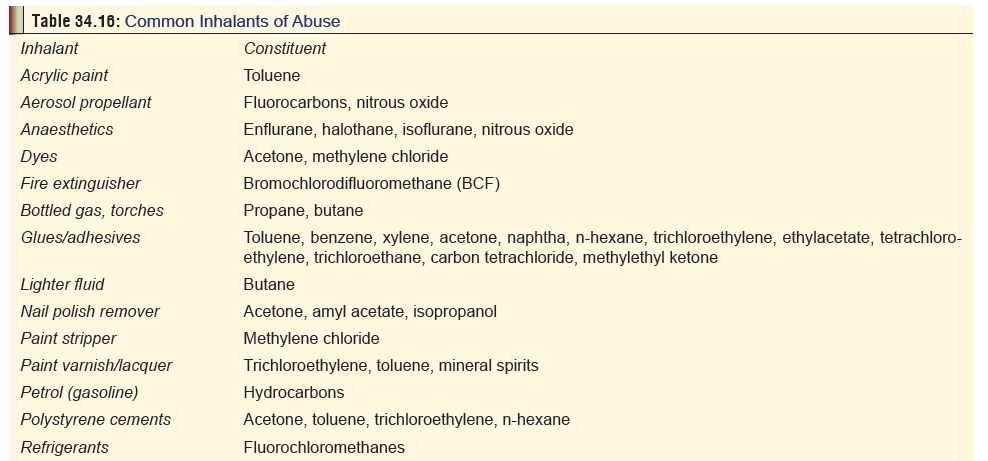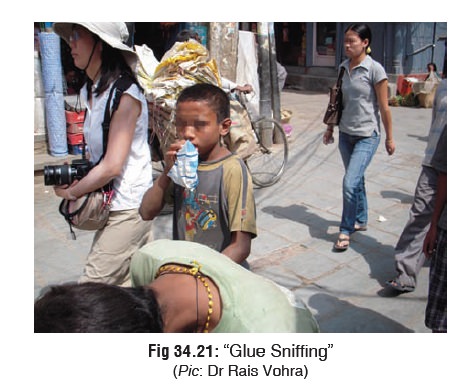Chapter: Modern Medical Toxicology: Substance Abuse: Substances of Dependence and Abuse
Inhalants (ŌĆ£Glue SniffingŌĆØ,Volatile Substance Abuse, Inhalant-related Disorders)
Inhalants (ŌĆ£Glue SniffingŌĆØ,Volatile Substance Abuse,
Inhalant-related Disorders)
Inhalant drugs (volatile substances)
are widely available and frequently abused, especially by adolescents from poor
socio-economic background. These substances are mostly volatile hydrocarbons
which are used as solvents, propellants, thinners, and fuels (Table 34.16). The hydrocarbon is
typically inhaled by pouring into a container for ŌĆ£sniffingŌĆØ, a rag or sock for
ŌĆ£huffingŌĆØ, or a plastic/paper bag for ŌĆ£baggingŌĆØ. Abusers often begin with
ŌĆ£sniffingŌĆØ (lower concentrations), and progress subsequently to ŌĆ£huffingŌĆØ and
ŌĆ£baggingŌĆØ (higher levels of exposure).

The
most commonly abused inhalants include toluene from paints and glues; petrol;
butane from cigarette lighter fluids; butyl and isobutyl nitrite; and
halogenated hydrocarbons from typewriter correction fluids, propellants, and
dry cleaning fluids.![]()
Inhalation
of volatile substances produces intoxicating effects rapidly. They are well
absorbed through the lungs and distributed quickly to the CNS. One or two huffs
will begin to intoxicate the user within seconds, and the effects usually last
for several hours. Chronic users can maintain a prolonged high with periodic
inhalations every few hours.
Clinical (Toxic) Features
1. Acute
CNSŌĆöExcitation,
agitation, hallucinations, headache,vertigo, nystagmus, ataxia, convulsions,
lethargy, stupor, respiratory depression.
CVSŌĆöArrhythmias
and sudden death (ŌĆ£sudden sniffing deathŌĆØ).
Other EffectsŌĆö
ŌĆōŌĆō
Methaemoglobinaemia (butyl and isobutyl nitrites).
ŌĆōŌĆō
Carbon monoxide poisoning (methylene chloride).
ŌĆōŌĆō
Hepatitis (chlorinated hydrocarbons).
ŌĆōŌĆō
Metabolic acidosis, rhabdomyolysis, renal failure, hypokalaemia (toluene).
2. Chronic
Chronic painter syndromeŌĆöA neurobehaviouralsyndrome due to solvent-induced encephalopathy, char-acterised by memory loss, anxiety, depression, sleep disorders, neurasthenia, and personality changes. CT
┬Ę
![]() scan often
reveals areas of atrophy, and EEG readings are usually abnormal.
scan often
reveals areas of atrophy, and EEG readings are usually abnormal.
┬Ę
Cerebellar dysfunction with chorea
(petrol).
┬Ę
Peripheral neuropathy (n-hexane).
┬Ę
Increased incidence of leukaemia,
aplastic anaemia, and multiple myeloma (benzene).
┬Ę
Abdominal pain, nausea, vomiting,
haematemesis.
┬Ę
Cardiomyopathy.
┬Ę
Hepatotoxicity.
┬Ę
Pulmonary disordersŌĆöpulmonary
hypertension, acute respiratory distress.
┬Ę
Dementia (leaded petrol, toluene).
Treatment
Inhalant intoxication, like alcohol
intoxication, usually requires no special treatment and resolves spontaneously.
However, complications such as cardiac arrhythmias, bronchospasm, coma, etc.
will require prompt treatment. Essentially, medical care primarily involves
reassurance, quiet environment, and attention to vital signs and level of
consciousness. Sedative drugs such as benzodiazepines are contraindicated,
since they may aggravate intoxication. Severe agitation may require cautious
control with haloperidol (5 mg for adults) intramus-cularly, repeated once
after 20 minutes if necessary.
Inhalant
dependence requires specialised treatment by a qualified psychiatrist, and may
take 3 to 12 months for achieving total abstinence. Relapses are not uncommon.
Forensic Issues
Volatile
substances abuse (VSA) is a uniquely adolescent phenomenon, and is particularly
common among lower socioeconomic classes, mainly because these substances are
cheap, easily available, and legal to possess. Also, the mode of intake is
relatively simple. VSA is quite common among street urchins of major Indian
cities, probably because these inexpensive substances offer a rare exciting
experience to escape from the daily misery of poverty (Fig 34.21). Persons with adolescent conduct disorder and adult
antisocial person-ality disorder are especially prone to VSA.

Related Topics